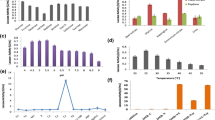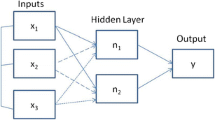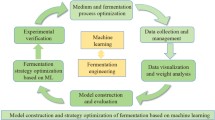Abstract
Trade in high-value-added toxins for therapeutic and biological use is expanding. These toxins are generally derived from microalgae belonging to the dinoflagellate family. Due to the difficulties to grow these sensitive planktonic species and to the complexity of methods used to synthesize these molecules, which are generally complex chemical structures, biotoxin manufacturers called on artificial intelligence technologies. Manufacturing processes have been greatly improved through the development of specific learning neural networks, applied to each phases of biotoxin production: photo-bioreactors operating at optimal yied; new chemical synthesis research processes; toxin biosynthetic research pathways offering short-cut possibilities.


Similar content being viewed by others
References
Ahneman DT, Estrada JG, Lin S, Dreher SD, Doyle AG (2018) Predicting reaction performance in C-N cross coupling using machine learning. Science 360:186–190. https://doi.org/10.1126/science.aar5169
Assunçao J, Guedes AA, Malcata FX (2017) Biotechnological and pharmacological applications of biotoxins and other bioactive molecules from dinoflagellates. Mar Drugs 15(12):393. https://doi.org/10.3390/md15120393
Brandessence Market Research via Comtex. Microalgae market 2019 industry research, share, trend, global industry size, price, analysis, regional outlook to 2025 research report. Aug 2019. https://brandessenceresearch.biz/Researchpostld=65810&
Cadoret JP, Murdor M, Lerouge P, Cabigliera M, Henriquiez V, Carlier A (2008) Les microalgues: usines cellulaires productrices de molécules commerciales recombinantes. Med Sci 24(4):735–782. https://www.ifremer.fr/docelec/
Cevora G (2019) The relationship between biological and artificial intelligence. eprint arXiv:1905.00547; Bibcode:2019arXiv190500547C
Cho Y, Tsuchiya S, Omura T, Koike K, Oikawa H, Kanoki K, Oshima Y, Yotsu-Yamshita M (2019) Metabolomic study of saxitoxin analogues and biosynthetic intermediates in dinoflagellates using 15N-labelled sodium nitrate as a nitrogen source. Sci Rep 9:3460. https://doi.org/10.1038/s41598-019-39708-y
Coley CW, Barzilay R, Jaakkola TS, Green WH, Jensen KJ (2017) Prediction of organic chemistry reactions outcomes using machine learning. ACS Cent 3:434–443. https://doi.org/10.1021/acscentsci.7b00064
Fleming JJ, Du Bois J (2006) A synthesis of (+)-saxitoxin. J Am Chem Soc 1281(2):3926–3927. https://doi.org/10.1021/ja0608545
Hamilton SH, Jakema AJ, Norton JP (2008) Artificial intelligence techniques: an introduction to their use for modelling environmental systems. Math Comp Simul 78(s 2–3):378–400. https://doi.org/10.1016/j.matcom.2008.01.028
Hoffmann RW (2012) Streamlining organic synthesis for the 21st century. Russ J Org Chem 48(5):625–637. https://doi.org/10.1134/5107042801
Hunter L, Mavrovouniotis M (1993) Artificial intelligence and biomolecular biology. American Association for Artificial Intelligence, Menlo Park (ISBN:0-262-58115-9)
Kellman R, Mihali TK, Jeon YJ, Pickford R, Pomati F, Neilan BA (2008) Biosynthetic intermediate analysis and functional homology reveal a saxitoxin gene cluster in cyanno bacteria. Appl Environ Microbiol 74(13):4044–4053. https://doi.org/10.1128/AEM.00353-08(Epub 2008)
Khan MI, Shin JH, Kim JD (2018) The promising future of microalgae: current status, challenges, and optimization of a sustainable and renewable industry for biofuels, feed, and other products. Microb Cell Fact 17:36. https://doi.org/10.1186/s12934-018-0879-x (PMCID: PMC5836383)
Klucznik T, Mikulak-Kluczni SL, Grzybowski BA (2018) Efficient syntheses of diverse, medicinally relevant targets planned by computer and executed in the laboratory. Chemistry 4:522–532. https://doi.org/10.1016/.chempr.2018.02.002
Kobayashi J (2016) Search for new bioactive marine natural products and application to drug development. Chem Pharm Bull 64(8):1079–1083. https://doi.org/10.1248/cpb/c16-00281
Lin G-M, Warden-Rothman R, Voigt CA (2019) Retrosynthetic design of metabolic pathways to chemicals not found in nature. Curr Opin Syst Biol 14:82–107. https://doi.org/10.1016/j.coisb.2019.04.004
Lone SH, Bhat KA (2015) Hemisynthesis of a naturally occurring clinically significant antitumor arglabin from ludartin. Tet Lett 56(14):1908–1910. https://doi.org/10.1016/j.tetlet.2015.02.100
Lukowski AL, Denomme N, Hinze ME, Hall S, Isom LL, Narayan ARH (2019) Biocatalytic detoxification of paralytic shellfish toxins. ACS Chem Biol 145:941–948. https://doi.org/10.1021/acschembio.9b00123(Epub 2019)
Newhouse T, Baran P, Hoffmann RW (2009) The economies of synthesis. Chem Soc Rev 38:3010–3021. https://doi.org/10.1039/B821200G
Segler MH, Preuss M, Waller MP (2018) Planning chemical syntheses with deep neural networks and symbolic AI. Nature 555(7698):604–610. https://doi.org/10.1038/nature25978
Singh V, Haque S, Niwas R, Srivastava A, Pasupuleti M, Tripathi CK (2016) Strategies for fermentation medium optimization: an in-depth review. Front Microbiol 7:2087. https://doi.org/10.3389/fmcib.2016.02087 (PMID: 2811566)
Sun Z, Lin T, Zhou ZG, Jiang Y (2016) Microalgae as a source of lutein: chemistry, biosynthesis and carotenogenesis. Adv Biochem eng/biotechnol 153:37–58. https://doi.org/10.1007/10_2015_331
Ten-Lohuis MR, Miller DJ (1998) Genetic transformation of dinoflagellates (Amphidinium and Symbiodinium): expression of GUS in microalgae using heterologous promoter constructs. Plant J 13:427–435. https://doi.org/10.1046/j.1365-313X.1998.00040.x
Tsuchiya S, Cho Y, Konoki K, Nagasawa K, Oshima Y, Yotsu-Yamashita M (2016) Biosynthetic route towards saxitoxin and shunt pathway. Sci Rep 6:20340. https://doi.org/10.1038/srep20340
Wei JN, Duvenaud D, Aspuru-Guzik A (2016) Neural networks for the prediction of organic chemistry reactions. ACS Cent Sci 2:725–732. https://doi.org/10.1021/acscentsci.6b00219
Acknowledgements
Thanks to Planktovie S.A for helpful discussions. Aix Marseille University (France) and A. Le Bivic and L. Kodjabachian, IBDM–CNRS Marseille directors, are greatly acknowledged for facilities offered.
Author information
Authors and Affiliations
Corresponding author
Additional information
Publisher's Note
Springer Nature remains neutral with regard to jurisdictional claims in published maps and institutional affiliations.
Rights and permissions
About this article
Cite this article
Kraus, Jl. Artificial intelligence applied to the production of high-added-value dinoflagellates toxins. AI & Soc 35, 851–855 (2020). https://doi.org/10.1007/s00146-020-00959-3
Received:
Accepted:
Published:
Issue Date:
DOI: https://doi.org/10.1007/s00146-020-00959-3




